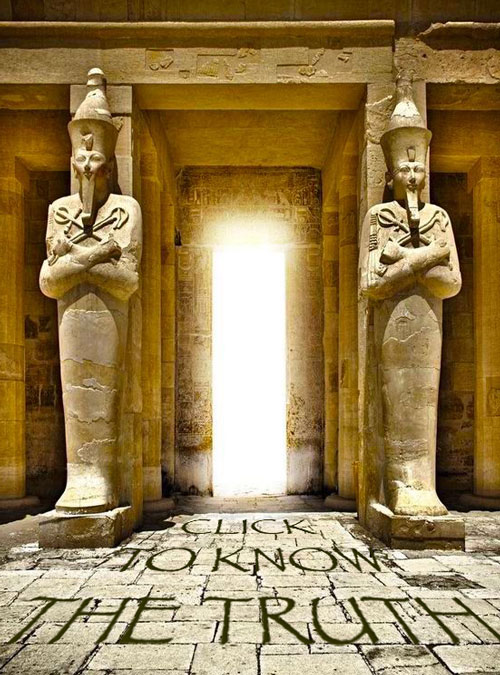The throne goddess
Here’s a bird’s eye view of the pyramids:

Notice that there are two golden rectangles in golden mean proportion to each other. At first glance this is an unusual arrangement that appears to lack any artistic merit. If we add clockwise Fibonacci spirals inside the rectangles however, it yields a rearing cobra:

Bearing this in mind, the snake also has a heavenly reference. In astronomy, an analemma is a diagram showing the apparent position of the Sun in the sky, as seen from a fixed location on Earth at the same mean solar time. This was once referred to as the Serpent in the Sky:

Apparent solar time is measured by the natural course of the Sun in the sky. Mean solar time is the theoretical cadence of the Sun if it traveled at a constant speed throughout the year—rather than its actual velocity that varies with the seasons. The difference between apparent and mean solar time is known as the equation of time. This comes from the medieval Latin aequātiō diērum, meaning “equation of days”.

Above: mean solar time can be measured by an hourglass
For thousands of years, the right time was accurately shown by a sundial. When water clocks and hourglasses were introduced, they agreed with sundials only four times a year, so the equation of time was used to “correct” their readings. In the graph below, a sundial will appear fast relative to a clock (above the x-axis) and slow (beneath) it:
 So the apparent Sun and the mean Sun may be as much as 16 minutes apart because the motion of the solar disc against the background of the stars speeds up and slows down annually. There are two reasons for this. Firstly, the Earth’s orbit is not circular and she moves at slightly different speeds in different seasons. Secondly, the Earth’s axis is tilted relative to the plane of her orbit.
So the apparent Sun and the mean Sun may be as much as 16 minutes apart because the motion of the solar disc against the background of the stars speeds up and slows down annually. There are two reasons for this. Firstly, the Earth’s orbit is not circular and she moves at slightly different speeds in different seasons. Secondly, the Earth’s axis is tilted relative to the plane of her orbit.
What history doesn’t record, however, is that the Rod of Asclepius was actually a gnomon, or the part of a sundial that casts a shadow. This simple stick was used for a variety of purposes—in this case it was used to measure the annual path of the Sun across the ground. Examining this in more detail yielded the solstices:

A serpent wrapped around a rod therefore, symbolised the path of the Sun from the shadow of a gnomon. Betraying the origins of the Caduceus, it is hard to imagine a simpler method of measuring time. Although a basic device, the gnomon was used in Egypt for thousands of years because it was so accurate:

The Egyptians called their gnomon the Was meaning “power”. Why did they put a head on it? Well, the “zenith pass” was a moment when the Sun was directly overhead and cast no shadow whatsoever. Because the sceptre was a hand-held device, it meant that the shadow of the bearer’s hand blocked the result on the ground. The solution was to put a head on it—at the moment of the zenith pass it would be the same length as the shadow:

The Sun therefore, is a solar deity who moves very much like a snake in the sky. Birds of prey also describe a serpentine motion as they wheel overhead. So the head of the Was sceptre symbolises the translation from light into shadow, cosmos into chaos. No surprises then, that a solar barque was found buried beside the Great Pyramid—it is a reminder of the path of the Sun.

So Giza was designed like a gigantic shadow from an imaginary gnomon. But the Egyptians realised something deeper—that this shadow had golden mean properties. Referencing the second image from top, we can now create a mirror of this pattern. Here we are reminded that the hourglass shape made by the Sun includes the orbital ratios of the planets:

Above: can you see the Ankh within the serpents of Isis and Nephthys?
So in the pattern above we have the union of golden mean rectangles and spirals. This is the masculine and feminine aspects that make up life—the Ankh. This was the master symbol of the Egyptians, as bequeathed by the movement of the Sun:

Above: the Throne of Isis
Ankh means “life” and refers to the fact that consciousness is mirrored—the ephemeral balance point between counterparts. This can be shown artistically as Isis and Nephthys, but in reality you just need to recognise the Caduceus and the Tree of Life as one. Now we start to see why Giza was so important—it screamed humanity as divinity.

As a winged goddess, Isis was also associated with the black kite. The mournful calls of this bird sounded like grieving women to the ancient Egyptians. The kite’s scavenging for carrion resembled her search for the scattered pieces of Osiris. The wings of Isis at Giza then, are symbolic of this airborne predator and reflect the devoted nature of her voice.
So this “call of love” then, echos the resonance of the universe. Eset, Eset, Eset! Within our hearts we can feel the passion of Osiris—we care for our loved ones, our colleagues and the work we do upon this Earth. Isis was the Madonna—the virgin mother whose love gave birth to the cosmos. Her metaphysical significance then, was always ex nihilo—the universe reborn out of nothing.
